HALF PRICE WINTER SALE – ORDER NOW FOR JANUARY DELIVERY
Menu
HALF PRICE WINTER SALE – ORDER NOW FOR JANUARY DELIVERY
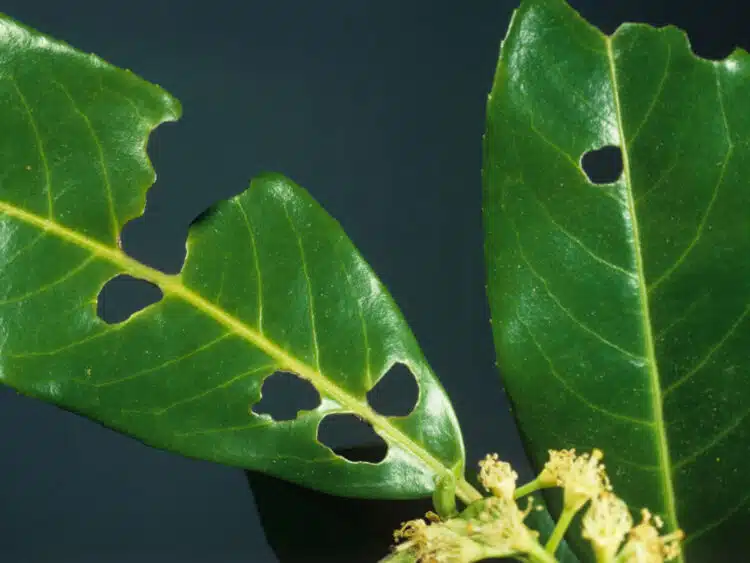 https://www.hopesgrovenurseries.co.uk/wp-content/uploads/2025/03/fungal-shot-hole-stigmina-750x563.jpg
why do my laurels have holes in their leaves
https://www.hopesgrovenurseries.co.uk/wp-content/uploads/2025/03/fungal-shot-hole-stigmina-750x563.jpg
why do my laurels have holes in their leaves
Imagine Eric Carle’s Very Hungry Caterpillar has been munching your Cherry Laurel or Portuguese Laurel plants, they have disconcerting, randomly spaced Swiss cheese style holes through the foliage – that’s what Laurel Shot Hole looks like.
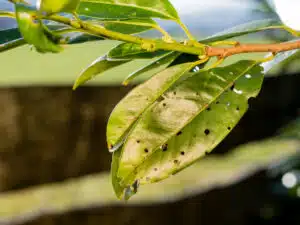
You would certainly be forgiven for thinking an insect had been eating them, but in fact it is caused by a variety of harmless fungi that can thrive on the surface of Laurels when conditions are just right. It’s usually when we get damp, cloudy weather conditions just when the Laurel plants are actively growing, so there are soft, young leaves ready for the fungal spores to colonise. Infections are usually worse in shady places with little air flow, for example the shady or north facing part of an established hedge, dank corners of the garden, or within a crop of fully developed Laurel hedging plants growing in their rows in the nursery.
When we get better weather (sunshine and a dry atmosphere) the pathogens are stopped in their tracks, new growth will almost always be unaffected. The older leaves will however bear the benign evidence of past infection, often until these older leaves are naturally shed the following year. While they may look a little unsightly, no harm is done.
These are the causes:
Powdery Mildew (caused by the Podosphaera fungus) can grow over the leaf surface, readily identified as a white powdery mould coating, more obvious on the underside of the leaf. Parts of the leaf can then turn brown and fall off leaving irregular, ragged holes through the affected leaves that looks rather like insect damage. The edges of the holes usually have a brown, corky appearance.
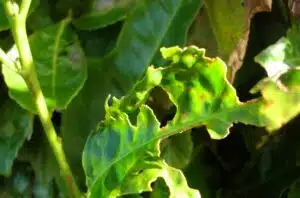
Leaf Spots (Caused by Stigmina and Eupropolella fungi) leave a much neater calling card, firstly brown spots appear on the leaves. As the plant controls the fungus infection naturally the diseased and healthy parts of the leaf separate with the brown spot falling out of the leaf leaving a neat circular hole (or ‘shot hole’).
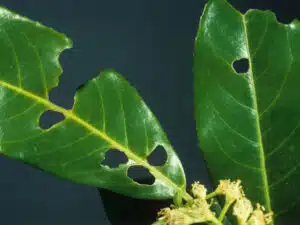
These fungal pathogens are mild and none of them pose any danger to the long-term health of your Laurel plants (which will grow fresh leaves in due course). The RHS does not recommend spraying fungicides, not only because these are weather related issues so they will not control it, but also because they frequently do a lot more harm than good in the wider ecosystem.
(These pathogens are not to be confused with Bacterial Shot Hole which I have dealt with separately with at the end of this article)
Prevention of fungal shot hole diseases
As these pathogens are natural, weather-related phenomena and a part of the wider ecosystem there is a certain sense of inevitability, but that’s not so say you can’t improve the odds! Here are some suggestions to help prevent the incidence of shot hole fungi:
Bacterial Shot Hole (Not a fungus, this is the bacterium Xanthomonas pruni) is a far more serious disease of Laurels and the wider Prunus plant family (which also includes many important commercial food crops such as Cherries, Plums, Almonds, Nectarines and Apricots). Xanthomonas pruni is quite rightly a notifiable disease, all commercially grown plants in the Prunus family including Laurels must be inspected during the growing season on the nursery, and before sale.
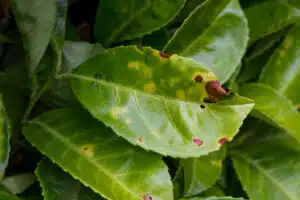
Xanthomonas pruni is spread by wind and rain, causing the bacteria to enter the leaves through either damaged tissues or the natural leaf openings (stomata). You can identify the disease by the yellow spots to begin with, they develop into light brown lesions that gradually become larger. Unlike the fungal shot hole diseases above, the lesions have a yellow halo around the edge. As the plant controls the infection, the infected and healthy parts of the leaf separate, and the centre drops out to leave irregular holes (but the yellow halo remains).
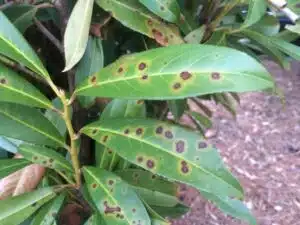
Like all good commercial nurseries, our Laurels are inspected regularly by APHA Plant Health and Seed Inspectors, thankfully we have never had a case of bacterial shot hole on the nursery. When you buy Laurel hedging plants from any reputable supplier like us you will see the XANTPR designation (short for Xanthomonas pruni) on the plant label attached to your plants when they arrive. This is your assurance that the plants we have sold you are from a ‘Pest Free Area’ free from Xanthomonas pruni.
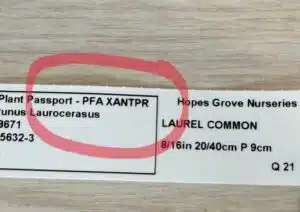
We are one of just a handful of online nurseries to have attained Plant Healthy certification. In a nutshell, it’s a way of proving that we will always do the right thing in preventing the spread of harmful plant pests and diseases. The Plant Healthy Management Standard is a voluntary initiative that sets out requirements…
Many of our customers buy topiary plants (and hedging plants) to grow in containers, one frequently asked question is how large does the pot that I plant them into need to be?
Expert horticultural advice on the merits and pitfalls of planting bare root yews, and how to get the best from them.